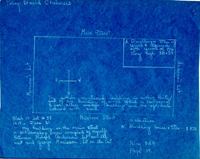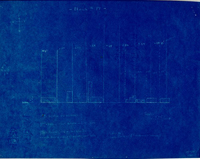Burdett's Ordinary Historical Report, Block 17 Building 2COriginally entitled: "Colonial Lot # 58 ("Burdette") Block 17, #I"
Colonial Williamsburg Foundation Library Research Report Series - 1321
Colonial Williamsburg Foundation Library
Williamsburg, Virginia
1990
COLONIAL LOT # 58 ("BURDETTE'S)
Block 17, # 1.
June 16, 1932.
obsolete
Digest of Data
Two buildings stood on colonial lot # 58, a tavern and a shop.
| Tavern: | Built 1718, see plat for elevation and size in 1743. See insurance policy for size in 1817. Encroached 8 feet over line of lot # 57, the lot immediately west. Tavern had a sign with irons called "The Sign of Edinburgh Castle" in 1743. Tavern very well furnished, notes on inventories in report; complete inventories on file. |
| Shop: | Built 1750 on 35 feet of eastern portion of lot. Story and a half; dormer windows; porch; front level with ground; back built up over gully. Razed 1883. Once Called the Coffee House. |
COLONIAL LOT # 58 ("BURDETTE'S")
Block 17, # 1.
June 16, 1932.
obsolete
In the early eighteenth century two buildings stood on this colonial lot # 58 which abuts the Capitol Square. One was erected in 1718 at which time Francis Sharpe, owner of lots 57 and 58 received a license to operate an ordinary in his dwelling house. The other was built about 1750.
Its strategic location near the Capitol made it an excellent tavern site and it served throughout the 18th century in that capacity. The tavern was on the western portion of the lot extending 8 feet into lot 57 and a building used as a shop and lodging house was on the eastern portion. The tavern at an early date was called "The Sign of Edinburgh Castle" and the shop shared the name "Coffee House" with several others of that title. For convenience in describing these two buildings they will hereafter be referred to as the tavern and the shop, respectively, the first being on the western boundary of the lot.
After Sharpe's death his son Jacob sold the entire lot to Thomas Pattison, an ordinary keeper. When Pattison died in 1743 he bequeathed his lot and houses in the occupation of John Burdett to his son Thomas after the death of his wife Anne. This indicates more than one 2 building on the lot at this date, perhaps outbuildings.
A complete inventory of Pattison's estate is available which indicates that his tavern was fairly large and well equipped with handsome furniture and furnishings. In the inventory is listed a sign with irons "The Sign of Edinburgh Castle" valued at 2/0/0, 13 beds (one or more to a room) equipment for 4 fireplaces and 18 [pair ?] window curtains.
On May 16, 1743 a survey of lots 57 and 58 was made to settle a dispute between John Burdette occupant of 58 and Seth Seekright tenant of Thomas Penman on # 57. A tracing of the original plat is appended to this report and the following report was made by the jury on the survey:
Book 19 - Wills & InventoriesSeekright, Seth - Plaintiff
vs. May 16 , 1743.
Burdett, John - Defendant.
...Surveyors Note:
In obedience to an order of York County Court dated the 16th of May 1743, I have surveyed the lot in dispute between Seth Seekright, lessee of Thomas Penman, Plaintiff and John Burdette, defendant, as each party directed, that is to say, the lot No. 57 claimed by the Plaintiff and the Lot No. 58 claimed by the defendant according to the above plan, by which it appears that the body of the defendants house stands about 8 feet on the plaintiffs lot. The prickt line A shows the bounds of Burdetts lot as held by Mr. Kerr, taking in ___ 14 feet from Penmans lot: and the prickt line B. taking about 4 ft. more, was lately a line of pales of Burdette.
Jos. Davenport-Surveyor
City Wmsburg.In the action of Trespass between Thomas Penman, Plaintiff and John Burdett, Defendant, this day came the parties aforesaid by their attornies and thereupon came a jury to-Wit: Andrew Anderson, Edward Baptist, John Goodwin, Jr, Wynne Edward Dobson, Edward Curtis, William Fuller, Edward Peters Edward Potter, James Goodwin, George Holloway and Hugh Orr, good and 3 lawful men who were elected, tryd and duly sworn to say the truth in the matter in issue and upon their oaths they say that the defendant is guilty of the trespass in the declaration mentioned and they assess the damages of the Plaintiff by occasion thereof to 5 pounds.
Therefore, it is considered by the Court that the Plaintiff recover against the said defendant his damages aforesaid by the jurors aforesaid in form aforesaid assessed, and also his costs by him abut his suit in this behalf expended and the said defendant in mercy, etc.
(York County Records - Book 19 -Wills and Inventories.)"
John Burdette died in 1746 bequeathing his tavern to his wife Mary and daughter Christianna. His tavern contained among a great many other items of furniture and furnishings [Full list available in Research Department] 10 beds and 1 couch, 7 benches, 27 chairs, 10 tables, 2 backgammon tables, 1 billiard table, 2 teaboards, 9 sconces (brass and tin) 3 lanthorns, 1 chimney glass, and 1 sign with the iron work (probably Edinburgh Castle)
Burdett's estate was advertises in the Virginia Gazette:
September 4, 1746.
On Wednesday the 19th of this Instant, will be Sold to the highest Bidder, (next Door to Mr. Prentis's, in Williamsburg,) all Sorts of Houshold Goods, and Kitchen Furniture; also Horses, Cows, a good Billiard Table, well furnish'd with Sticks and Balls, a Quantity of choice old Madeira Wine, and old Barbados Rum, Ale, Arrack, and several other Sorts of Liquors. Likewise a very good Two-wheel'd Chaise, with Harness for two Horses; it being the personal Estate of Mr. John Burdett, deceas'd...
Christiana Burdett,
Administratrix. (Virginia Gazette - William Parks, Ed.)
About 1750 a shop, or as it was called in the eighteenth century, a store house, was built on the eastern portion of 4 lot 58. On August 30 of that year the shop was sold by Robert Crichton, merchant to Nathaniel Walthoe for 350 £, indicating a large and valuable building.
Thomas Pattison junior, sold the lot the evidence suggest that Burdette [illegible] west portion from Pattison to Benjamin Waller. Thirty five feet at the eastern end of the lot were conveyed to Robert Crichton merchant who built a storehouse (shop) on it prior to August 4, 1750. At this time he sold it to Nathaniel Walthoe, merchant for the large sum of £ 350.
Walthoe sold the property to Benjamin Bayley, a merchant on April 1, 1759 for £ 400 but in 1762 1772?it was back in his hands again. When he died his heirs sold the building in 1772 to Charlotte Dickson, a milliner. Charlotte Dickson owned this ¼ of a lot until her death, about 1801.
William Rind, the printer took over the tavern in February 1767 and used it as a shop and printing office until his death in 1773. He lived at the "Paradise house" and the inventory of his estate shows that the building lot 58 was used as a printing office only.
David Meade owned the tavern at the close of the eighteenth century having acquired it prior to 1789, probably from John Webb.
David Chalmers acquired the tavern in 1817 from Joseph Hague who had acquired it from James Thomson previously. He insured it in 1817, a tracing of the policy accompanies this report.
Morrison owned the shop and house on the eastern portion of lot 58 as early as 1810, and after Chalmers death in 1835 1808 (Ro. Anderson acct.) 5 purchased the western portion also.
Mr. Charles in his "Recollections of Williamsburg" describes the two buildings as they appeared just prior to the war:
Where the home of Mr. Donegan now stands, there stood, until after the "War-Between-the-States", a two story frame house, with porch on the western front, which was used as a residence; and in the eastern end there was a store for many years, which had the distinction of having been the only store here for a long period of the War.
The last house on this square facing on Duke of Gloucester Street was upon the present site of Mrs. D. Armistead's residences and was known as the "Morrison" house. This was a story-and-a-half frame house, with dormer windows. There was a porch along the western end. The front of this old house was about on a level with the street; but was high from the ground at the back. This old domicile was evidently also one of the originals, and being worn out in service, it was pulled down in 1883. An old maiden lady with her four bachelor brothers lived in this old house within the memory of the writer; which being located so close to the "Capitol" may have, in its early days, sheltered such worthies as G. Washington, T. Jefferson, G. Mason, and P. Henry; but tradition is silent, and they did not then have the telephone to "call up" the newspaper and give in the "personals".Between this "Morrison" house, just described, and the old "Chancery" office, Blair Street is shown on the map (old), and seems to be a continuation of the street running diagonally from Francis Street about in front of the "Peyton Randolph" house across Duke of Gloucester until it intersects Nicholson Street. This has never been developed and is now an unused bottom with weeds and briars in profusion.
Harold R. Shurtleff, Director
Department of Research & Record.
Report By: Helen Bullock
HB/vbl
cc: P. S. & H, B. and W.; Dr. W. A. R. G.; A. A. S.

